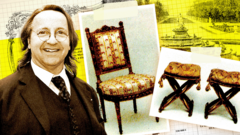In the early 2010s, a pair of intricately designed chairs that allegedly adorned the Palace of Versailles drew considerable attention in the French antiques market. As claimed, these exceptional pieces of furniture were among the most lavish creations for Marie Antoinette, the last queen of France before the revolution, and were marked with the seal of respected cabinet maker Nicolas-Quinibert Foliot from the 18th century. Recognized as "national treasures" by the French government in 2013, the chairs attracted interest from Versailles itself, although the asking price was deemed excessive, leading to their sale to Qatari Prince Mohammed bin Hamad Al Thani for an astounding €2 million (£1.67 million).
The proliferation of 18th-century royal furniture on the market has been noteworthy, with various pieces supposedly connected to notable French figures of the era, including additional chairs thought to have been in Marie Antoinette's chambers. Many of these items found their way back to Versailles' collection, while other significant pieces were sold to affluent collectors. However, in 2016, a scandal erupted, unraveling a nine-year investigation that implicated some of France's top antiques experts in a grave fraud.
The inquiry led to the indictment of Georges "Bill" Pallot, a renowned antique scholar, and award-winning artisan Bruno Desnoues on charges of fraud and money laundering. Both defendants recently faced court proceedings in Pontoise, with Pallot and Desnoues acknowledging their roles, while gallery director Laurent Kraemer contested the charges against his establishment.
Initially starting as an experiment, Pallot and Desnoues sought to replicate an armchair from Madame du Barry. Their skillful reproductions, which managed to deceive experts, prompted them to produce more. Pallot recounted in court how they sourced low-cost wood frames and fabricated materials, creatively employing authentic-looking stamps that added to their artifice. Though they claimed to earn around €700,000 from their venture, prosecutors argue the profits exceeded €3 million.
Trust between experts and institutions like Versailles has significantly eroded due to this incident, with Pallot's inside access to vital historical archives further complicating the trust issue. The French history of such impressive craftsmanship was brought into question as the court emphasized the importance of stringent regulations in the art market.
The fraudulent scheme came to light when suspicious activities regarding a middleman’s luxurious possessions led authorities to explore deeper connections in the art world. Some initial accusations were deemed unfounded; however, defrauding parties like Kraemer's gallery faced repercussions for their lack of due diligence that allowed these falsifications to proliferate in the first place.
In court, Kraemer's defense team vehemently asserted their client's victimization in the scam while the prosecution called for more rigorous scrutiny from the art world to prevent future deceptions of this scale. With their credibility compromised and trust in the French antiques market shaken, such revelations underscore a new imperative for accountability in the intersection of art and commerce.




















